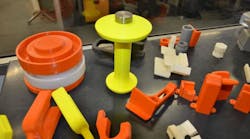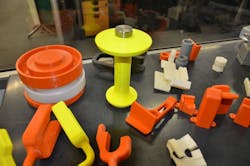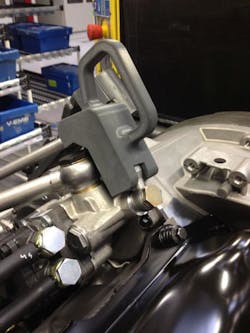There’s been a lot of talk of late about how 3D printing will cause big disruptions to the freight world – indeed, how this technology could fundamentally chance how we manufacture just about all the goods we use in our daily lives. (Go here and here for more detail on those two themes.)
Simply put, 3D printing – which is also known as “additive manufacturing” or AM – takes almost any three dimensional object created in a digital environment and then “prints” it out via the “layering” of various materials such as plastic, metal, etc.
Some feel that, eventually, we’ll be able to make vehicles with 3D printers, thereby replacing the giant assembly lines that daily craft cars and trucks by the thousands.
We’re not there yet, but the company noted in the race car creation video above – Stratasys Ltd. – is starting down that road in the truck making world, as its 3D printing technology is allowing Sweden’s Volvo Trucks to craft production line parts faster and cheaper.
Pierre Jenny, manufacturing director at Volvo Trucks, noted in a statement that the Swedish OEM reduced the time needed to create specific production line tooling from 36 days to just two days with Stratasys’ 3D printing system.
Jenny estimated that, where customized or small quantities of tools are required, the “all-in cost”of using 3D printing to craft such items from thermoplastic can cost in some cases as little as $1.13 per 0.06 cubic inches, compared to the traditional price point for such items (which are usually made of metal) of roughly $113 per 0.06 cubic inches.
"Stratasys’ 3D printing has made an incredible impact to the way we work,” he added. “The capability to produce a virtually unlimited range of functional tools in such a short timeframe is unprecedented and enables us to be more experimental and inventive to improve production workflow.”
Jean-Marc Robin, technical manager for Volvo Trucks, noted that the kinds of tools the OEM is crafting via 3D printing include a range of durable yet lightweight clamps, jigs, supports and even ergonomically-designed tool holders that ensure a more organized working environment for its production line operators.
"We're working in the heavy-industry sector, so reliability is naturally critical. So far every piece that we have 3D printed has proved to be 100% fit-for-purpose," he said. "This is crucial from a practical aspect, but also instills trust among operators and quashes any traditional notion that everything has to be made from metal in order to function properly.”According to Robin, developing production tools using additive manufacturing also enables the equipment design team to be far more responsive, while avoiding possible wastage in the event of last minute design changes before tools are made.
"The fast and cost-effective nature of additive manufacturing means that we are far less restricted than we were even six months ago, allowing us to constantly improve our processes," he noted.
Robin also point out that if a mistake is made – if operators find the tooling or part is the wrong length, for example – the 3D printing team can simply alter the design specifications and “re-print” the piece in a few hours.
"From a time and cost perspective, this is unimaginable with traditional techniques,” he stressed.
Eventually, one hopes the savings generated by 3D printing’s role in the truck making process might filter down to the buyer – perhaps helping alleviate the hike in commercial vehicle sticker prices we’ve seen over the last decade due to the imposition of emission control mandates and other requirements by the U.S. government. We’ll see how that goes.





